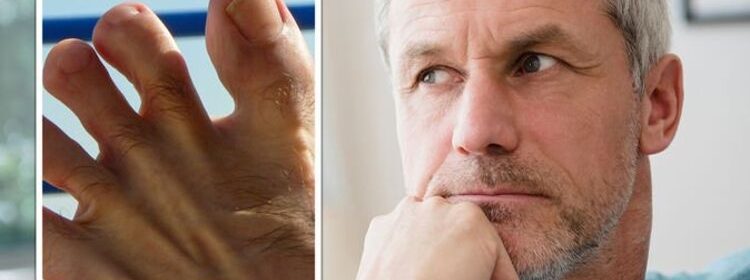Diabetes type 2: Foot issues can signal high blood sugar – ‘see your doctor’ immediately

Diabetes UK show how to test feet for diabetic feet sensitivity
We use your sign-up to provide content in ways you’ve consented to and to improve our understanding of you. This may include adverts from us and 3rd parties based on our understanding. You can unsubscribe at any time. More info
Experts advise to “see your doctor” immediately if you experience any of the following foot issues, which signal serious complications of high blood sugar. The Centers for Disease Control and Prevention (CDC) warned that any tingling, burning, or pain in the feet needs to be checked over by a medical health professional. Diabetics also need to notify their health team if they experience a change in the shape of their feet over time.
Furthermore, any hair loss on the toes or feet are another warning sign of complications from high blood sugar.
So too is dry, cracked skin on the feet or a change in colouring, or temperature, of the lower limbs.
Also be on the lookout for thickened, yellow toenails, or a fungal infection, such as athlete’s foot.
Moreover, any blister, sore, ulcer, infected corn, or ingrown toenail needs to be looked at.]

The CDC states: “If you experience any of these symptoms, don’t wait for your next appointment. See your regular doctor or foot doctor right away.”
The charity Diabetes UK elaborated on how high blood sugar can damage your feet.
Raised blood sugar levels can dampen the sensations you feel in your feet, the charity explained.
As such, circulation could be gravely impacted, leading to less blood supply to the area.

Consequently, cuts and sores can take much longer to heal, and if an infection takes hold, an amputation might be on the horizon.
Nerve damage, known as peripheral neuropathy, puts a diabetic at risk of “Charcot foot”.
How does high blood sugar lead to nerve damage?
Diabetes UK explained that high blood sugar “can damage the small blood vessels that supply your nerves”.
This prevents the blood vessels from receiving the essential nutrients they need.
“Because of this, the nerves throughout your body can become damaged or, over time, disappear.
“This means you may start to lose the sense of feeling in your hands, feet or legs.”
Without the ability to feel your feet, you will not be able to feel when an injury has taken place.
By walking on the injured foot, for example, the pressure can cause bone and joints to change shape, altering the shape of your foot.

A misshapen foot is also at increased risk of a foot ulcer, and further down the line, amputation.
The warning signs of Charcot foot
- Swelling
- Warmth – the affected foot feels warmer than the other
- Change in foot colour
- Change in foot shape.
These are serious warning signs that must be looked at by a healthcare professional as soon as possible.
By getting into the habit of checking your feet every day, you can get ahead of any developing foot issues.
Source: Read Full Article